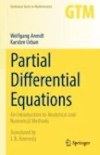- About MAA
- Membership
- MAA Publications
- Periodicals
- Blogs
- MAA Book Series
- MAA Press (an imprint of the AMS)
- MAA Notes
- MAA Reviews
- Mathematical Communication
- Information for Libraries
- Author Resources
- Advertise with MAA
- Meetings
- Competitions
- Programs
- Communities
- MAA Sections
- SIGMAA
- MAA Connect
- Students
- MAA Awards
- Awards Booklets
- Writing Awards
- Teaching Awards
- Service Awards
- Research Awards
- Lecture Awards
- Putnam Competition Individual and Team Winners
- D. E. Shaw Group AMC 8 Awards & Certificates
- Maryam Mirzakhani AMC 10 A Awards & Certificates
- Two Sigma AMC 10 B Awards & Certificates
- Jane Street AMC 12 A Awards & Certificates
- Akamai AMC 12 B Awards & Certificates
- High School Teachers
- News
You are here
Partial Differential Equations

Publisher:
Springer
Publication Date:
2023
Number of Pages:
476
Format:
Hardcover
Series:
Graduate Texts in Mathematics
Price:
79.99
ISBN:
978-3031133787
Category:
Textbook
[Reviewed by , on ]
John D. Cook
12/31/2023
James Kennedy has translated the textbook Partial Differential Equations by Wolfgang Arendt and Karsten Urban from German into English. Are there so few PDE textbooks in English that it is worth translating a German PDE text? There are indeed many PDE textbooks, particularly in English, but hardly any that present analytic and numerical methods on an equal footing. Of the two authors, Arendt leans toward the analytic side and Urban to the computational side, and together their textbook does justice to both.
The first third of the book is devoted to modeling and elementary methods. Much of this material might be found in either a book devoted to analytic or computational methods. For example, Fourier series and separation of variables could be viewed as either a theoretical or computational technique.
The elementary methods are not that elementary. The presentation is more sophisticated than one would normally find in an undergraduate differential equation textbook. For example, this section includes maximum principles for elliptic and parabolic PDEs and touches on issues of convergence with Fourier series.
The “elementary” methods are so-called to contrast with the next third of the book on Hilbert space methods such as the theory surrounding the Lax-Milgram theorem. Sobolev spaces are central to this theory, and here the authors do something unusual: before defining Sobolev spaces in full generality, the authors first devote a warm-up chapter to the special case of Sobolev spaces of functions of one real variable. In this context the abstract setting of distributional derivatives is not far removed from the more concrete setting of Lebesgue’s theory of differentiation. Over a finite interval \( [a, b] \), functions in the Sobolev space \( H^{1} \) can be taken to be continuous functions, making the theory more tangible and eliminating the need for trace theorems to handle boundary conditions.
The final section of the book covers numerical methods, both finite difference methods and finite element methods. Numerous numerical exercises are suggested. The numerical section is an integrated part of the book. For example, the presentation on finite element methods can use Sobolev norms without special explanation because these were developed earlier in the book.
This book would make a good textbook because of the broad selection of material. The book devotes at least some space to every aspect of PDEs one might expect to see in an introductory graduate level course, and then some. An instructor wanting to emphasize one aspect or another may find enough material in the book. If not, the instructor could use what is in the book as a launching point and add supplementary material. The spectrum of material from concrete to abstract gives a well-rounded introduction to partial differential equations.
John D. Cook is an independent consultant applying mathematics to data privacy.
See the publisher's website.
- Log in to post comments




